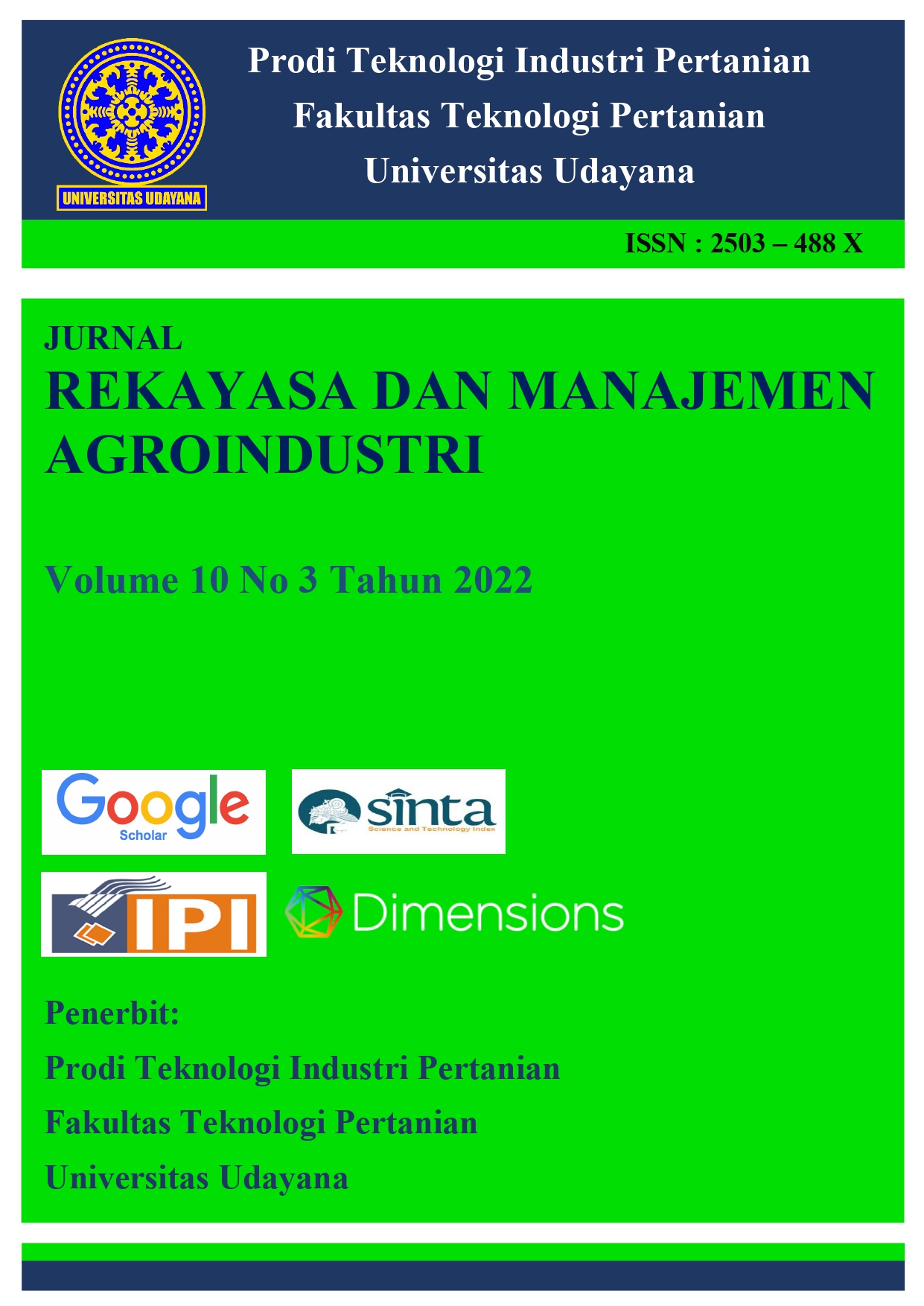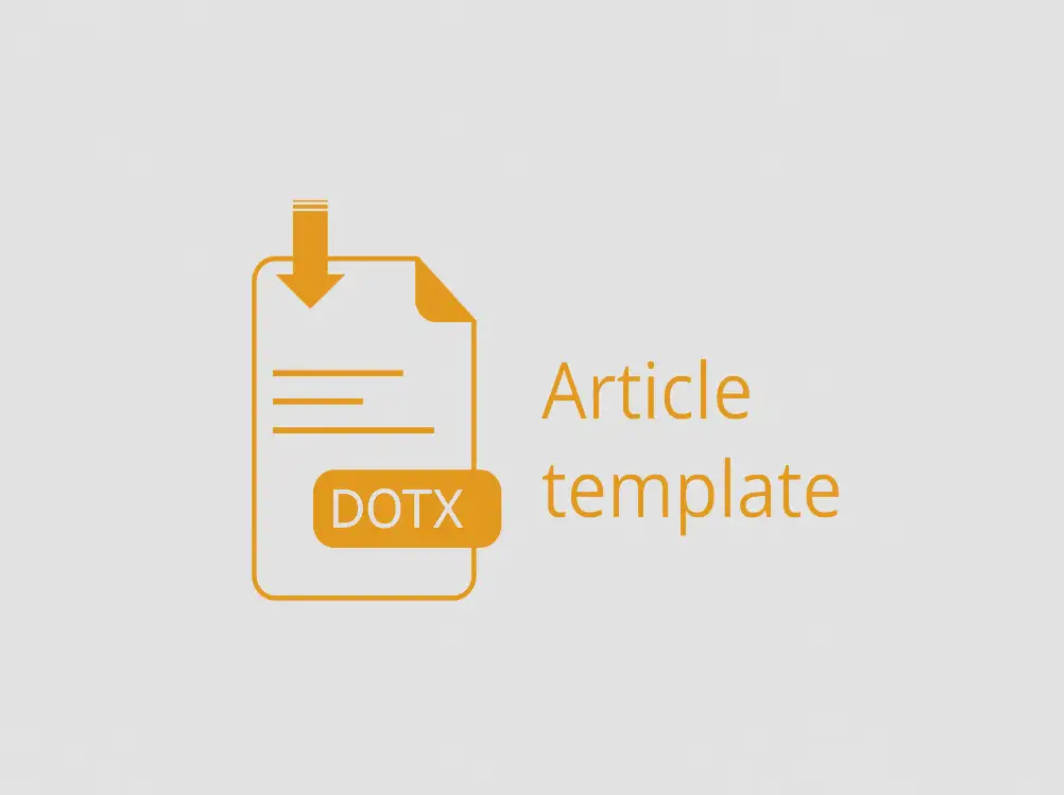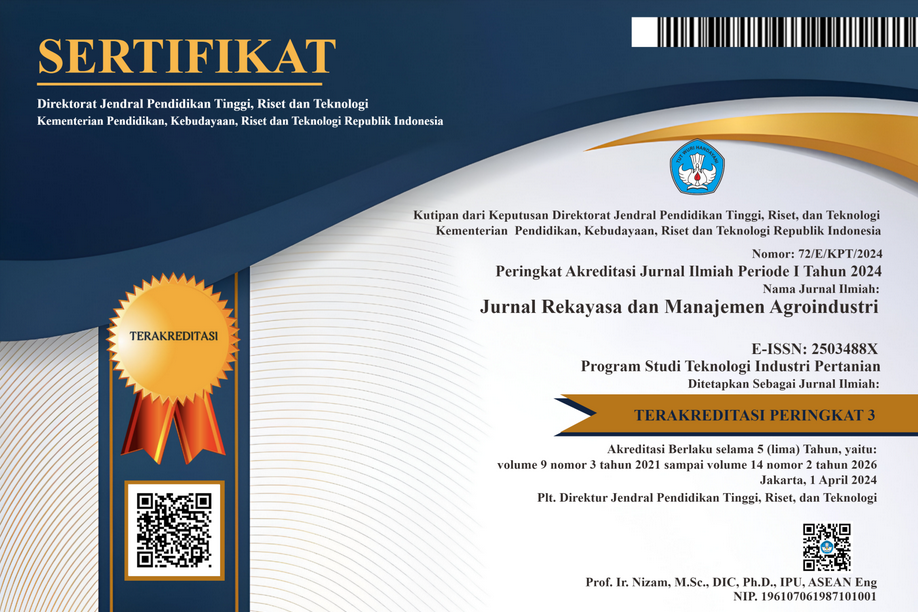KARAKTERISTIK KARBOKSIMETIL SELULOSA DARI ONGGOK SINGKONG PADA VARIASI KONSENTRASI NATRIUM HIDROKSIDA DAN ASAM TRIKLOROASETAT
Abstract
Onggok is tapioca solid waste that contains high cellulose but has not been used appropriately. This study aims to determine the concentration of NaOH and TCA to produce the best CMC characteristics of onggok. The study used a factorial randomized block design. The factor I was the concentration of NaOH (15%; 30%; and 45%), and factor II was the concentration of TCA (10%; 20%; and 30%). The variables observed included yield, water content, degree of substitution, NaCl content, and purity. The results showed that the concentration of NaOH and TCA significantly affected the yield, water content, degree of substitution, NaCl content, and purity of CMC. The concentrations of 45% NaOH and 30% TCA produced the best CMC characteristics with yield, moisture content, degree of substitution, viscosity, NaCl content, and CMC purity of 109.65±0.78%, 9.57±0.53%, 1.13±0.12, 170.00±10.00cPs, 0.86±0.40%, and 99.14±0.40%, respectively.
Downloads
References
Fibriyani, D. (2017). Pengolahan Onggok Singkong Sebagai Plastik Biodegradable Menggunakan Plasticizer Gliserin Dari Minyak Jelantah. Jurnal Aplikasi Teknologi Pangan, 6(2), 74–77. Jia, F., Liu, H., & Zhang, G. (2016). Preparation of Carboxymethyl Cellulose from Corncob. Procedia Environmental Sciences, 31, 98–102. K. Adhianto*, Muhtarudin, A. Husni, M. F. Z. (2019). Pengaruh Pemberian Limbah Singkong Terfermentasi Dan Mineral Mikro Organik Dalam Ransum Terhadap Penampilan Kambing Effect of Fermented Cassava Waste And Organic Micro Minerals In Rations Against Performance of Goats. Sains Perternakan, 17(2), 12–16.Kamal, N. (2010). Pengaruh Bahan Aditif Cmc ( Carboxyl Methyl Cellulose ) Terhadap Beberapa Parameter Pada Larutan Sukrosa. Jurnal Teknologi, I(17), 78–85.Maulina, Z., Adriana, A., & Rihayat, T. (2019). PENGARUH VARIASI KONSENTRASI NaOH DAN BERAT NATRIUM MONOKLOROASETAT PADA PEMBUATAN (Carboxymethyl Cellulose) CMC DARI SERAT DAUN NENAS (Pineapple-leaf fibres). Jurnal Sains Dan Teknologi Reaksi, 17(2). Nisa, D., & Putri, W. D. R. (2014). Pemanfaatan Selulosa Dari Kulit Buah Kakao ( Teobroma cacao L . ) Sebagai Bahan Baku Pembuatan CMC ( Carboxymethyl Cellulose ) Cellulose Utilization in Cacao Pod Husk ( Theobroma cacao L .) as Raw Material for CMC ( carboxymethyl cellulose ) Synthesis. Jurnal Pangan Dan Agroindustri, 2(3), 34–42.NURLAILA, R. (2021). Pemanfaatan Jerami Padi (Oryza Sativa L.) Sebagai Bahan Baku Dalam Pembuatan CMC (Carboximetil Cellulose). Jurnal Rekayasa Proses, 15(2), 194.Nurviqah, C. (2019). Pembuatan Karboksimetil Selulosa (CMC) dari Selulosa Kulit Nangka Muda (Artocarpus heterophyllus) dan Aplikasinya Pada Pembuatan Selai Nanas (Ananas comosus). Skripsi, Cmc.Purba, M. P. (2018). SINTESIS DAN KARAKTERISASI CMC (CARBOXYMETHYL CELLULOSE) DARI SELULOSA BATANG PISANG RAJA (Musa paradisiaca) DENGAN VARIASI NATRIUM MONOKLOROASETAT. Skripsi.Rahim, E. A., Turumi, G. S., & Bahri, S. (2021). Pemanfaatan Selulosa dari Rumput Gajah (Pennisetum purpureum) pada Sintesis Karboksimetil Selulosa (CMC) [Utilization of Cellulose from Pennisetum purpureum at The Synthesis of Carboxy Methyl Cellulose (CMC)]. KOVALEN: Jurnal Riset Kimia, 7(2), 146–153. Safitri, D., Abdul Rahim, E., & Sikanna, R. (2017). SINTESIS KARBOKSIMETIL SELULOSA (CMC) DARI SELULOSA KULIT DURIAN (Durio zibethinus) [Synthesis of Carboxymethyl Cellulose (CMS) of Durian Peel (Durio Zibethinus) Cellulose]. Kovalen, 3(1), 58–68.Santoso, S. P., Sanjaya, N., & Ayucitra, A. (2018). Pemanfaatan kulit singkong sebagai bahan baku pembuatan Natrium Karbosimetil Selulosa. Jurnal Teknik Kimia Indonesia, 11(3), 124. Silsia, D., Efendi, Z., & Timotius, F. (2018). Characterization of Carboxymethyl Cellulose (Cmc) From Palm Midrib. Jurnal Agroindustri, 8(1), 53–61.Singh, R. K., & Singh, A. K. (2013). Optimization of reaction conditions for preparing carboxymethyl cellulose from corn cobic agricultural waste. Waste and Biomass Valorization, 4(1), 129–137. Wekridhany. (2012). Pengaruh Rasio Selulosa / NaOH pada Tahap Alkalinisasi Terhadap Produksi Natrium. Jurusan Teknik, Fakultas Teknik, Universitas Bandar Lampung, 978.Wijaya, S. M., Pitaloka, A. B., & Saputra, A. H. (2014). Sintesis dan Karakterisasi Carboxymethyl Cellulose ( CMC ) dari Selulosa Eceng Gondok ( Eichhornia crassipes ) dengan Media Reaksi Isopropanol Etanol. International Conference on Advance Material and Practical Nanotechnology (ICAMPN), 3(1), 1–11.
Wijayani, A., Ummah, K., & Tjahjani, S. (2010). CHARACTERIZATION OF CARBOXY METHYL CELLULOSE (CMC) FROM Eichornia crassipes (Mart) Solms. Indonesian Journal of Chemistry, 5(3), 228–231. https://doi.org/10.22146/ijc.21795Zhang, J., Li, D., Zhang, X., & Shi, Y. (1993). Solvent effect on carboxymethylation of cellulose. Journal of Applied Polymer Science, 49(4), 741–746.

Ciptaan disebarluaskan di bawah Lisensi Creative Commons Atribusi-BerbagiSerupa 4.0 Internasional.
Seluruh artikel di Jurnal ini dapat disebarluaskan atas tetap mencantumkan sumber yang syah. Identitas judul artikel tidak boleh dihilangkan. Penerbit tidak bertangggung jawab terhadap naskah yang dipublikasikan. Isi artikel menjadi tanggung jawab Penulis.














